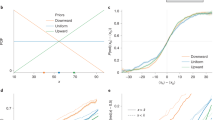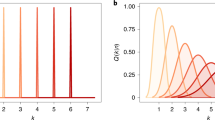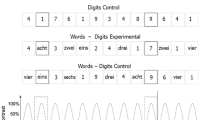Abstract
Humans are often required to compare average magnitudes in numerical data; for example, when comparing product prices on two rival consumer websites. However, the neural and computational mechanisms by which numbers are weighted, integrated and compared during categorical decisions are largely unknown1,2,3,4,5. Here, we show a systematic deviation from ‘optimality’ in both visual and auditory tasks requiring averaging of symbolic numbers. Participants comparing numbers drawn from two categories selectively overweighted larger numbers when making a decision, and larger numbers evoked disproportionately stronger decision-related neural signals over the parietal cortex. A representational similarity analysis6 showed that neural (dis)similarity in patterns of electroencephalogram activity reflected numerical distance, but that encoding of number in neural data was systematically distorted in a way predicted by the behavioural weighting profiles, with greater neural distance between adjacent larger numbers. Finally, using a simple computational model, we show that although it is suboptimal for a lossless observer, this selective overweighting policy paradoxically maximizes expected accuracy by making decisions more robust to noise arising during approximate numerical integration2. In other words, although selective overweighting discards decision information, it can be beneficial for limited-capacity agents engaging in rapid numerical averaging.
This is a preview of subscription content, access via your institution
Access options
Access Nature and 54 other Nature Portfolio journals
Get Nature+, our best-value online-access subscription
$29.99 / 30 days
cancel any time
Subscribe to this journal
Receive 12 digital issues and online access to articles
$119.00 per year
only $9.92 per issue
Buy this article
- Purchase on Springer Link
- Instant access to full article PDF
Prices may be subject to local taxes which are calculated during checkout




Similar content being viewed by others
References
Tsetsos, K., Chater, N. & Usher, M. Salience driven value integration explains decision biases and preference reversal. Proc. Natl Acad. Sci. USA 109, 9659–9664 (2012).
Tsetsos, K. et al. Economic irrationality is optimal during noisy decision making. Proc. Natl Acad. Sci. USA 113, 3102–3107 (2016).
Brezis, N., Bronfman, Z. Z., Jacoby, N., Lavidor, M. & Usher, M. Transcranial direct current stimulation over the parietal cortex improves approximate numerical averaging. J. Cogn. Neurosci. 28, 1700–1713 (2016).
Brezis, N., Bronfman, Z. Z. & Usher, M. Adaptive spontaneous transitions between two mechanisms of numerical averaging. Sci. Rep. 5, 10415 (2015).
Malmi, R. A. & Samson, D. J. Intuitive averaging of categorized numerical stimuli. J. Verbal Learning Verbal Behav. 22, 547–559 (1983).
Kriegeskorte, N. & Kievit, R. A. Representational geometry: integrating cognition, computation, and the brain. Trends Cogn. Sci. 17, 401–412 (2013).
Scott, B. B., Constantinople, C. M., Erlich, J. C., Tank, D. W. & Brody, C. D. Sources of noise during accumulation of evidence in unrestrained and voluntarily head-restrained rats. eLife 4, e11308 (2015).
Wyart, V. & Koechlin, E. Choice variability and suboptimality in uncertain environments. Curr. Opin. Behav. Sci. 11, 109–115 (2016).
Gibbon, J. Scalar expectancy theory and Weber’s law in animal timing. Psychol. Rev. 84, 279–325 (1977).
Moyer, R. S. & Landauer, T. K. Time required for judgements of numerical inequality. Nature 215, 1519–1520 (1967).
Dehaene, S., Dupoux, E. & Mehler, J. Is numerical comparison digital? Analogical and symbolic effects in two-digit number comparison. J. Exp. Psychol. Hum. Percept. Perform. 16, 626–641 (1990).
Van Opstal, F., de Lange, F. P. & Dehaene, S. Rapid parallel semantic processing of numbers without awareness. Cognition 120, 136–147 (2011).
Kelly, S. P. & O’Connell, R. G. Internal and external influences on the rate of sensory evidence accumulation in the human brain. J. Neurosci. 33, 19434–19441 (2013).
O’Connell, R. G., Dockree, P. M. & Kelly, S. P. A supramodal accumulation-to-bound signal that determines perceptual decisions in humans. Nat. Neurosci. 15, 1729–1735 (2012).
Nili, H. et al. A toolbox for representational similarity analysis. PLoS Comput. Biol. 10, e1003553 (2014).
Woodford, M. Prospect theory as efficient perceptual distortion. Am. Econ. Rev. 102, 41–46 (2012).
Li, V. L., Castañón, S. H., Solomon, J. A., Vandormael, H. & Summerfield, C. Robust averaging protects decisions from noise in neural computations. Preprint at bioRxiv https://doi.org/10.1101/147744 (2017).
Twomey, D. M., Murphy, P. R., Kelly, S. P. & O’Connell, R. G. The classic P300 encodes a build-to-threshold decision variable. Eur. J. Neurosci. 42, 1636–1643 (2015).
Donchin, E. & Coles, M. G. H. Is the P300 component a manifestation of context updating? Behav. Brain Sci. 11, 357–374 (1988).
Sutton, S., Braren, M., Zubin, J. & John, E. R. Evoked-potential correlates of stimulus uncertainty. Science 150, 1187–1188 (1965).
Picton, T. W. The P300 wave of the human event-related potential. J. Clin. Neurophysiol. 9, 456–479 (1992).
Bulthé, J., De Smedt, B. & Op de Beeck, H. P. Visual number beats abstract numerical magnitude: format-dependent representation of Arabic digits and dot patterns in human parietal cortex. J. Cogn. Neurosci. 27, 1376–1387 (2015).
Eger, E. et al. Deciphering cortical number coding from human brain activity patterns. Curr. Biol. 19, 1608–1615 (2009).
Harvey, B. M., Klein, B. P., Petridou, N. & Dumoulin, S. O. Topographic representation of numerosity in the human parietal cortex. Science 341, 1123–1126 (2013).
Dehaene, S. The organization of brain activations in number comparison: event-related potentials and the additive-factors method. J. Cogn. Neurosci. 8, 47–68 (1996).
Libertus, M. E., Woldorff, M. G. & Brannon, E. M. Electrophysiological evidence for notation independence in numerical processing. Behav. Brain Funct. 3, 1 (2007).
Wyart, V., Myers, N. E. & Summerfield, C. Neural mechanisms of human perceptual choice under focused and divided attention. J. Neurosci. 35, 3485–3498 (2015).
Ille, N., Berg, P. & Scherg, M. Artifact correction of the ongoing EEG using spatial filters based on artifact and brain signal topographies. J. Clin. Neurophysiol. 19, 113–124 (2002).
Spitzer, B., Blankenburg, F. & Summerfield, C. Rhythmic gain control during supramodal integration of approximate number. NeuroImage 129, 470–479 (2016).
Grootswagers, T., Wardle, S. G. & Carlson, T. A. Decoding dynamic brain patterns from evoked responses: a tutorial on multivariate pattern analysis applied to time series neuroimaging data. J. Cogn. Neurosci. 29, 677–697 (2017).
Nili, H., Walther, A., Alink, A. & Kriegeskorte, N. Inferring exemplar discriminability in brain representations. Preprint at bioRxiv https://doi.org/10.1101/080580 (2016).
Maris, E. & Oostenveld, R. Nonparametric statistical testing of EEG- and MEG-data. J. Neurosci. Methods 164, 177–190 (2007).
Acknowledgements
This work was supported by grants from the German Research Foundation to B.S. (DFG SP 1510/1-1 and DFG SP 1510/2-1) and a European Research Council Starter Grant (281628) to C.S. The funders had no role in study design, data collection and analysis, decision to publish or preparation of the manuscript. We thank V. Li, T. Flesch and H. Nili for helpful suggestions and scripts, F. Blankenburg for resources, A. Epure for help with data acquisition and R. Kievit for helpful comments on a previous version of the manuscript.
Author information
Authors and Affiliations
Contributions
B.S. designed the experiments with contributions from L.W. and C.S. L.W. and B.S. conducted the experiments. B.S. and C.S. developed the analysis approach. B.S. analysed the data with contributions from C.S. B.S. and C.S. wrote the paper.
Corresponding author
Ethics declarations
Competing interests
The authors declare no competing interests.
Supplementary information
Supplementary Information
Supplementary Methods, Supplementary Figures 1–3
Rights and permissions
About this article
Cite this article
Spitzer, B., Waschke, L. & Summerfield, C. Selective overweighting of larger magnitudes during noisy numerical comparison. Nat Hum Behav 1, 0145 (2017). https://doi.org/10.1038/s41562-017-0145
Received:
Accepted:
Published:
DOI: https://doi.org/10.1038/s41562-017-0145
This article is cited by
-
Moving a missing hand: children born with below elbow deficiency can enact hand grasp patterns with their residual muscles
Journal of NeuroEngineering and Rehabilitation (2024)
-
Evidence integration and decision confidence are modulated by stimulus consistency
Nature Human Behaviour (2022)
-
Asymmetric reinforcement learning facilitates human inference of transitive relations
Nature Human Behaviour (2022)
-
Efficient coding of numbers explains decision bias and noise
Nature Human Behaviour (2022)
-
Concurrent visual working memory bias in sequential integration of approximate number
Scientific Reports (2021)



